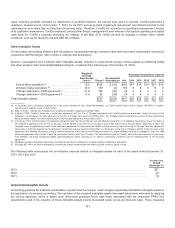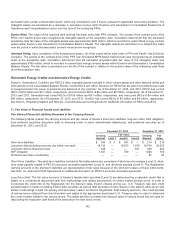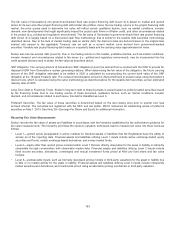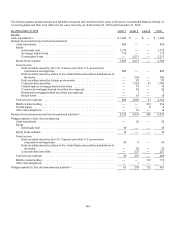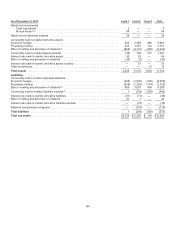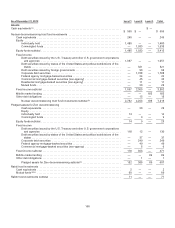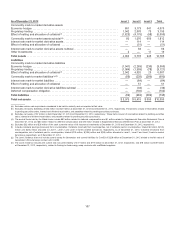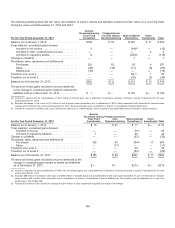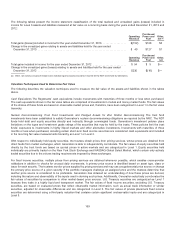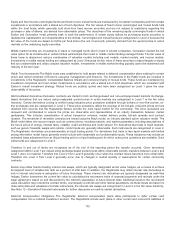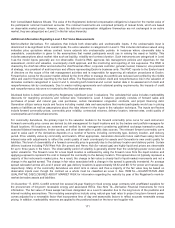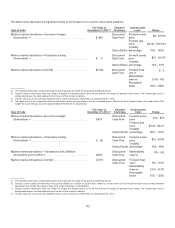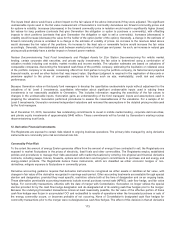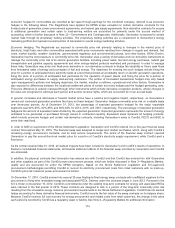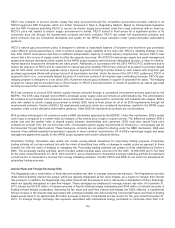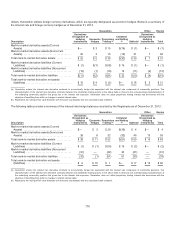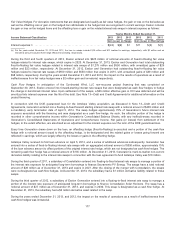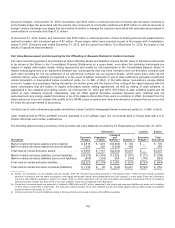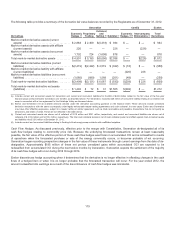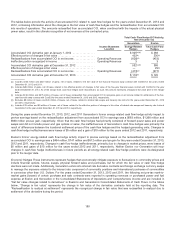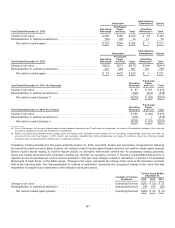ComEd 2013 Annual Report Download - page 177
Download and view the complete annual report
Please find page 177 of the 2013 ComEd annual report below. You can navigate through the pages in the report by either clicking on the pages listed below, or by using the keyword search tool below to find specific information within the annual report.theirConsolidatedBalanceSheets. Thevalue oftheRegistrants’ deferredcompensation obligationsisbasedon themarket value of
the participants’ notional investment accounts. The notional investmentsare comprisedprimarilyofmutual funds, which are based
on observable market prices. However,sincethedeferredcompensation obligationsthemselvesare not exchangedinanactive
market,theyare categorizedasLevel 2 inthefairvalue hierarchy.
Additional Information Regarding Level 3 Fair Value Measurements
Mark-to-Market Derivatives. For valuationsthat includebothobservable andunobservable inputs, if the unobservable input is
determinedto besignificant to theoverall inputs, the entire valuation is categorizedinLevel 3. This includesderivativesvaluedusing
indicativepricequotationswhosecontract tenure extends into unobservable periods. Ininstanceswhere observable data is
unavailable,consideration is given to theassumptionsthat market participantswoulduseinvaluingtheasset or liability. This
includesassumptionsabout market risks such asliquidity, volatilityandcontractduration.Such instrumentsare categorizedinLevel
3asthemodel inputsgenerallyare not observable.Exelon’s RMC approvesrisk management policiesandobjectivesfor risk
assessment,control andvaluation,counterpartycredit approval,andthemonitoringandreportingofrisk exposures. TheRMC is
chairedbythechiefrisk officer andincludesthechieffinancial officer,corporate controller,general counsel,treasurer, vice president
ofstrategy, vice president ofauditservicesandofficersrepresentingExelon’s business units. TheRMC reportsto theExelon board
ofdirectorson thescope oftherisk management activitiesandisresponsible for approvingall valuation proceduresat Exelon.
Forwardpricecurvesfor thepower market utilizedbythefront officetomanagethe portfolio are reviewedandverifiedbythemiddle
officeandusedfor financial reportingbytheback office.TheRegistrantsconsider creditandnonperformancerisk inthevaluation of
derivativecontractscategorizedinLevel 2 and3,includingboth historical andcurrent market data initsassessment ofcreditand
nonperformancerisk by counterparty. Due to master nettingagreementsandcollateral postingrequirements, theimpactsofcredit
andnonperformancerisk were not material to thefinancial statements.
DisclosedbelowisdetailsurroundingtheRegistrants’ significant Level 3 valuations. Thecalculatedfairvalue includesmarketability
discountsfor marginingprovisionsandnotional size.Generation’s Level 3 balancegenerallyconsistsofforwardsalesand
purchasesofpower andnatural gas, coal purchases, certain transmission congestion contracts, andprojectfinancingdebt.
Generation utilizesvariousinputsandfactorsincludingmarket data andassumptionsthat market participantswoulduseinpricing
assetsor liabilitiesaswell asassumptionsabout therisks inherent intheinputsto thevaluation technique.Theinputsandfactors
includeforwardcommodityprices, commoditypricevolatility, contractual volumes, deliverylocation,interest rates, creditqualityof
counterpartiesandcreditenhancements.
For commodityderivatives, theprimaryinput to thevaluation modelsistheforwardcommoditypricecurvefor each instrument.
Forwardcommoditypricecurvesare derivedbyrisk management for liquid locationsandbythe tradersandportfoliomanagersfor
illiquid locations. All locationsare reviewedandverifiedbyrisk management consideringpublishedexchange transaction prices,
executedbilateral transactions, broker quotes, andother observable or public data sources. The relevant forwardcommoditycurve
usedto value each ofthederivativesdepends on a number offactors, includingcommoditytype,deliverylocation,anddelivery
period. Pricevolatilityvariesbycommodityandlocation.When appropriate,Generation discountsfuture cash flows usingrisk free
interest rateswithadjustmentsto reflectthecreditqualityofeach counterpartyfor assetsandGeneration’s owncreditqualityfor
liabilities. Thelevel ofobservabilityofaforwardcommoditypriceis generallydue to thedeliverylocation anddeliveryperiod. Certain
deliverylocationsincluding PJM WestHub(for power)andHenryHub(for natural gas) are highlyliquid andpricesare observable
for up to three yearsinthefuture.Theobservabilityperiodofvolatilityisgenerallyshorter than theunderlyingpower curveusedin
option valuations. Theforwardcurvefor a less liquid location is estimatedbyusingtheforwardcurvefromtheliquid location and
applyingaspreadto represent thecost to transport thecommodityto thedeliverylocation. This spreaddoesnot typicallyrepresent a
majorityoftheinstrument’s market price.Asaresult,thechangeinfairvalue is closelytiedto liquid market movementsandnot a
changeinthe appliedspread. Thechangeinfairvalue associatedwithachangeinthespreadisgenerally immaterial.An average
spreadcalculatedacross all Level 3 power andgasdeliverylocationsisapproximately$3.92and$0.12 for power andnatural gas,
respectively. Manyofthecommodityderivativesare short termin nature andthusamajorityofthefairvalue maybebasedon
observable inputseven though thecontractasawhole mustbeclassifiedasLevel 3.See ITEM 7A.—QUANTITATIVE AND
QUALITATIVE DISCLOSURES ABOUT MARKET RISK for information regardingthematuritybyyear oftheRegistrant’s mark-to-
market derivativeassetsandliabilities.
OnDecember 17, 2010,ComEd enteredinto several 20-year floatingto fixedenergy swap contractswithunaffiliatedsuppliersfor
the procurement oflong-termrenewable energy andassociatedRECs. See Note 12—DerivativeFinancial Instrumentsfor more
information.Thefairvalue oftheseswapshasbeen designatedasaLevel 3 valuation due to the longtenure ofthepositionsand
internal modelingassumptions. Themodelingassumptionsincludeusingnatural gasheat ratesto project longtermforwardpower
curvesadjustedbya renewable factor that incorporatestimeofdayandseasonalityfactorsto reflectaccurate renewable energy
pricing. Inaddition,marketabilityreservesare appliedto thepositionsbasedon the tenor andsupplier risk.
171


